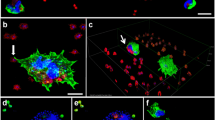Abstract
Azithromycin achieves high concentrations in phagocytic cells and in fibroblasts. The newer macrolides also have this property but the intracellular penetration of azithromycin in relation to extracellular concentration is particularly notable. As a weak base, azithromycin is thought to concentrate in lysosomes of phagocytes and fibroblasts but many in vitro factors such as pH and temperature also affect the uptake process. Uptake of azithromycin by polymorphonuclear leucocytes results in an intracellular/extracellular concentration ratio of approximately 40 after one hour of incubation. Intraphagocytic antimicrobial activity has been demonstrated but is rather less than might be anticipated from the intracellular concentrations that are reached. Importantly, the high antibiotic levels found intracellularly do not appear to disrupt normal phagocyte function. Although azithromycin levels in the blood are low soon after administration, tissue concentrations are high and sustained. It appears that fibroblasts serve as a reservoir of drug in tissue, allowing activity against organisms and possibly transferring antibiotic to phagocytic cells for activity against intracellular phathogens and delivery to infection sites.
Similar content being viewed by others
References
Prokesch RC, Hand WL: Antibiotic entry into human polymorphonuclear leukocytes. Antimicrobial Agents and Chemotherapy 1982, 21: 373–380.
Foulds G, Shepard RM, Johnson RB: The pharmacokinetics of azithromycin in human serum and tissues. Journal of Antimicrobial Chemotherapy 1990, 25, Supplement A: 73–80.
Wildfeuer A, Laufen H, Müller-Wening D, Haferkamp O: Interaction of azithromycin and human phagocytic cells. Uptake of the antibiotic and the effect on the survival of ingested bacteria in phagocytes. Arzneimittel-Forschung/Drug Research 1989, 39: 755–758.
Van der Auwera P, Matsumoto T, Husson M: Intraphagocytic penetration of antibiotics. Journal of Antimicrobial Chemotherapy 1988, 22: 185–192.
Carlier MB, Zenebergh A, Tulkens PM: Cellular uptake and subcellular distribution of roxithromycin and erythromycin in phagocytic cells. Journal of Antimicrobial Chemotherapy 1987, 20, Supplement B: 47–56.
Steinberg TH, Hand WL: Effect of phagocyte membrane stimulation on antibiotic uptake and intracellular bactericidal activity. Antimicrobial Agents and Chemotherapy 1987, 31: 660–662.
Ishiguro M, Koga H, Kohno S, Hayashi T, Yamaguchi K, Hirota M: Penetration of macrolides into human polymorphonuclear leucocytes. Journal of Antimicrobial Chemotherapy 1989, 24: 719–729.
Gladue RP, Bright GM, Isaacson RE, Newborg MF: In vitro and in vivo uptake of azithromycin (CP-62,993) by phagocytic cells: possible mechanism of delivery and release at sites of infection. Antimicrobial Agents and Chemotherapy 1989, 33: 277–282.
Baldwin DR, Wise R, Andrew JM, Ashby JP, Honeybourne D: Azithromycin concentrations at the site of pulmonary infection. European Respiratory Journal 1990, 3: 886–890.
de Duve C, de Barsy T, Poole B, Trouet A, Tulkens P, van Hoof F: Lysosomotrophic agents. Biochemical Pharmacology 1974, 23: 2495–2531.
Gladue RP, Snider ME: Intracellular accumulation of azithromycin by cultured human fibroblasts. Antimicrobial Agents and Chemotherapy 1990, 34: 1056–1060.
Pruul H, Wetherall B, McDonald P: In vitro killing of erythromycin — exposed group A streptococci by polymorphonuclear leukocytes. European Journal of Clinical Microbiology 1986, 5: 405–410.
Hand WL, King-Thompson NL, Johnson D: Influence of bacterial-antibiotic interactions on subsequent antimicrobial activity of alveolar macrophages. Journal of Infectious Diseases 1984, 149: 271–276.
Gemmell CG, O'Dowd A: Regulation of protein A biosynthesis inStaphylococcus aureus by certain antibiotics: its effect on phagocytosis by leukocytes. Journal of Antimicrobial Chemotherapy 1983, 12: 587–597.
Horowitz MA, Silverstein SC: Intracellular multiplication of Legionnaires' diseases bacteria(Legionella pneumophila) in human monocytes is reversibly inhibited by erythromycin and rifampicin. Journal of Clinical Investigation 1983, 71: 15–26.
Anderson R, Joone G, van Rensberg CEJ: An in vitro investigation of the intracellular bioavailability of amoxicillin, clindamycin, and erythromycin forStaphylococcus aureus. Journal of Infectious Diseases 1986, 153: 593–600.
Labro MT, el Benna J, Babin-Chevaye C: Comparison of the in-vitro effect of several macrolides on the oxidative burst of human neutrophils. Journal of Antimicrobial Chemotherapy 1989, 24: 561–572.
Schwab JC, Mandell GL: The importance of penetration of antimicrobial agents into cells. Infectious Disease Clinics of North America 1989, 3: 461–467.
Steingrimsson O, Olafsson JH, Thorarinsson H, Ryan RW, Johnson RB, Tilton RC: Azithromycin in the treatment of sexually transmitted disease. Journal of Antimicrobial Chemotherapy 1990, 25, Supplement A: 109–114.
Mallory S: Azithromycin in comparison with cephalexin in the treatment of skin and skin structure infections. American Journal of Medicine 1991, 91, Supplement 2B.
Milatovic D: Intraphagocytic activity of erythromycin, roxithromycin and azithromycin. European Journal of Clinical Microbiology and Infectious Diseases 1990, 9: 33–36.
Author information
Authors and Affiliations
Rights and permissions
About this article
Cite this article
McDonald, P.J., Pruul, H. Phagocyte uptake and transport of azithromycin. Eur. J. Clin. Microbiol. Infect. Dis. 10, 828–833 (1991). https://doi.org/10.1007/BF01975835
Issue Date:
DOI: https://doi.org/10.1007/BF01975835




